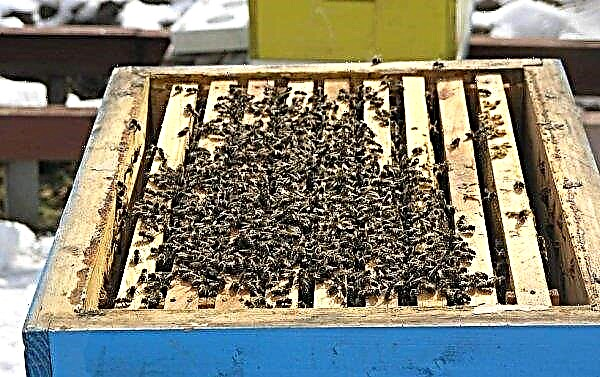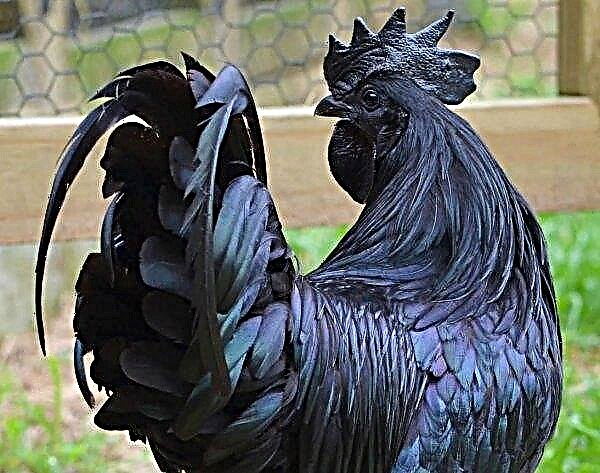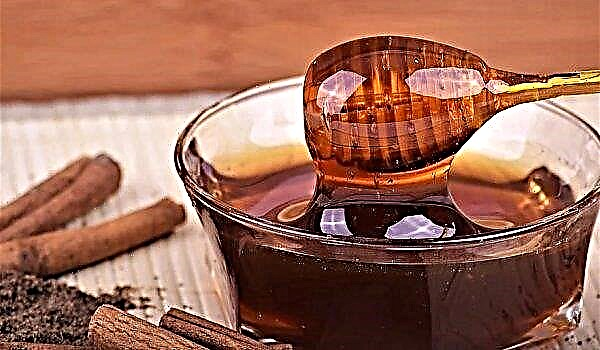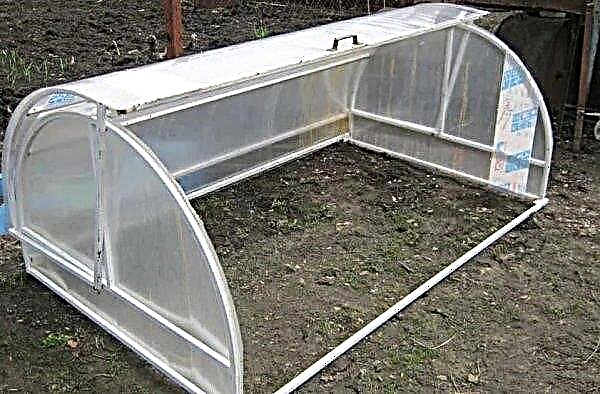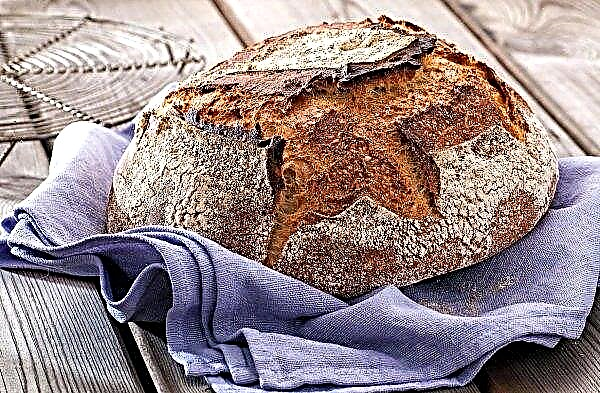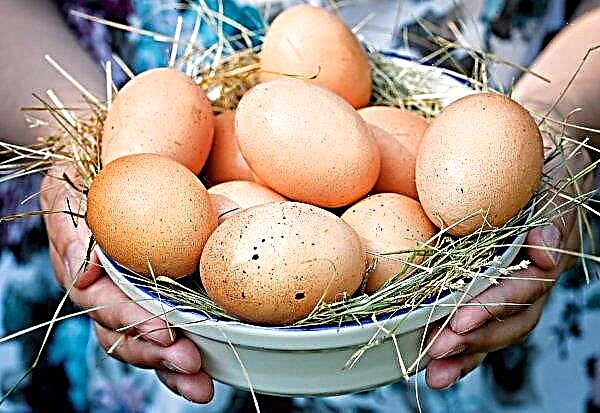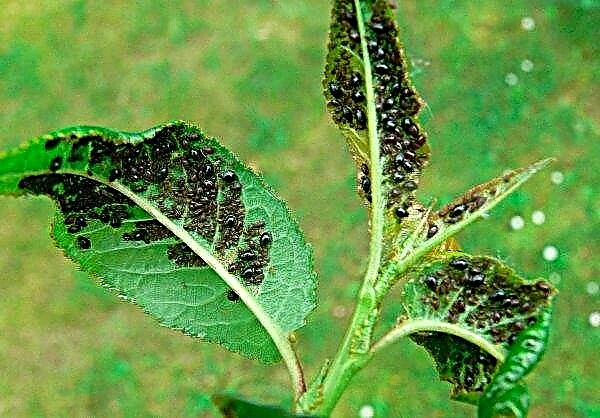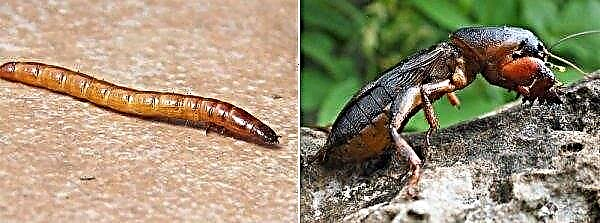Tsikas is a fairly hardy indoor plant, but improper care can cause him severe damage, which is manifested in yellowing of the leaves, as well as their twisting and termination of growth. We will talk about what are the causes of the problem of yellow leaves in the specified flower and how to avoid this, in the article.
Basic rules for growing cicas
Before you buy a cicada for growing at home, you need to choose a suitable place for it in the apartment, and if the plant is purchased as an adult, then you need to provide a lot of space for it. Particular attention must be paid to the light mode. The flower grows well with enough sun, but do not allow direct sunlight to fall on it. You can also grow cicada in a shaded room.
Did you know? Cycases are sometimes described as living minerals. This is due to the fact that the plant lived on the planet back in the Mesozoic era, when dinosaurs walked the earth.
The flower itself grows quite slowly, so do not sound the alarm about this. In the room where the cicada is contained, it is necessary to maintain coolness. The basic rule for growing this ornamental plant is regular feeding. But it is better to take organic fertilizers that do not contain potassium and magnesium. Do not use mineral dressings.
Why do the leaves of cicas turn yellow
Yellowing of the leaves of this flower is often found in an apartment, but the problem is easy to remove, understanding the reasons and eliminating them. To do this, you need to analyze the living conditions of the plant and remove the influence of negative factors, which we will consider below.
Excess or moisture deficit
Tsikas is very demanding on watering, so it is precisely the amount of moisture that needs to be paid special attention. One of the reasons for changing the color of greenery in a plant may be a lack of moisture. Some gardeners too reduce the frequency of watering in the winter, but this can only be done if the degrees in the room have also decreased. But if the batteries run at full capacity and the apartment feels hot, then this can lead to even more evaporation of moisture than in summer: the plant can simply die from dehydration. But the main reason that the cicada is yellow is overflow.
Did you know? Eastern medicine considers cicas as a medicinal plant. Its leaves are used in the treatment of cancer, as well as with severe hematomas.
It is better to leave the soil a little dry rather than pouring it to a state of dirt. Due to the abundant moisture in the plant, the roots may rot, which will lead to the loss of a flower. To remove unwanted changes in the plant, you must initially establish a watering regime. In summer, you need to water the cicadas moderately, but do not allow the soil to completely dry out. In winter, the amount of moisture must be reduced, but the amount of watering should depend on the temperature of the air inside the room: the colder the air, the less often you need to moisten the soil, and with increasing temperature, you need to increase the amount of water. In summer, it is advisable to cover the plant cone with moss, which should be moistened from the spray gun as it dries, without depriving the attention of the leaves of the cicas. The most correct way of watering is considered to be humidification through the pan, because if moisture constantly gets on the cone, the risk of rot on it increases. From this, the plant can die very quickly.
In summer, it is advisable to cover the plant cone with moss, which should be moistened from the spray gun as it dries, without depriving the attention of the leaves of the cicas. The most correct way of watering is considered to be humidification through the pan, because if moisture constantly gets on the cone, the risk of rot on it increases. From this, the plant can die very quickly.
Water should be pre-settled and soft, and its temperature should coincide with room temperature or be slightly warmer. It is not advisable to water the plant so that the liquid falls on its crown. To ensure complete hydration of the cicasus, it is best to simply irrigate it or wrap the entire trunk with moistened moss. It is also recommended that you wipe the foliage from time to time soaked in warm water and a well-wrung sponge.
Lack of useful components in the ground
Due to the insufficient amount of minerals in the soil, the plant most often discards leaves, but if other factors are added to it, then the cicada may turn yellow. It is recommended to feed cicas at the time of its active development: usually this period falls on April - August. Fertilize the soil 2 times a month. In the store you can buy fertilizer for palm trees or any universal dressings that do not have magnesium and potassium in their composition. You can also use cow or horse manure, which must be slightly diluted with water.
Fertilize the soil 2 times a month. In the store you can buy fertilizer for palm trees or any universal dressings that do not have magnesium and potassium in their composition. You can also use cow or horse manure, which must be slightly diluted with water.
Wrong place choice
If the air in the room is stale, and the plant cannot air, then this will lead to a change in the color of the greenery. In addition, if little light enters the flower, this will lead to deformation of the new leaves.
It is also worth avoiding drafts - this situation is often found in northern latitudes or in winter. In order to avoid trouble, while ventilating the room, remove the flower from the room or cover it.
Pests
The described indoor plant can often be attacked by various pests - most often it is a scab and a spider mite. Flower owners often begin to pay attention to this only after the cicada has turned yellow. The spider mite usually attacks the plant if the air in the apartment is too dry. Usually it can be seen by thin cobwebs on the leaves, the insect itself is hardly noticeable. You can remove the parasite with the help of chemicals, such as, for example, Actellic. However, if adult insects die, there is no guarantee that no larvae remain on the cicas, on which the poison does not act, so it is better to repeat treatment with the drug after a few days. You can also use laundry soap, foaming it heavily. Foam should be applied to the foliage and covered with cicas polyethylene for 24 hours. In the future, the procedure is recommended to be repeated every other day.
However, if adult insects die, there is no guarantee that no larvae remain on the cicas, on which the poison does not act, so it is better to repeat treatment with the drug after a few days. You can also use laundry soap, foaming it heavily. Foam should be applied to the foliage and covered with cicas polyethylene for 24 hours. In the future, the procedure is recommended to be repeated every other day.
Important! After you have treated the plant with soap and made sure that there are no more pests, the flower must be thoroughly washed with water.
As a preventive measure against the re-emergence of the pest, it is recommended to moisten the cicas daily with a spray gun. Another enemy of cicas is considered to be scabies. It can attack a flower due to the cold air temperature in the room and overflow of soil. In this case, the greens not only turns yellow, but also dries. In addition, white spots may appear on it. The plant can also be treated with Actellica and quarantined for a week.
What to do so that the leaves do not turn yellow
To determine the cause of yellowing of the cicas, the first thing to do is see where the plant has changed. If this happened to the lower tier, then there is no need to worry - this means that the old greenery is dying. If the cicada is yellowed at the ends of the leaves, then first of all it is necessary to moisten the air and make the watering more plentiful. Another way to hydrate a plant is to use a shower. You can rinse the palm tree under warm water, but before that it is necessary to cover the soil with oilcloth so that water does not stagnate on the stem and it does not begin to rot.
Important! If it happened that you poured soil, then you need to replace it by laying drainage at the bottom of the pot. In this case, the plant can not be watered for another 2-3 days.
Very often, the roots and trunk of a plant can rot. In this case, the affected areas of the plant are removed with a knife, which should be clean and well sharpened. The already trimmed cicada is soaked in a 30% fungicide solution, and the sections are covered with ash. After the manipulations, the plant should be left to dry for 2-3 hours. For better adaptation of the flower, it is recommended to use an accelerator of root growth. Then the palm tree is planted in a new small pot, where perlite or coarse sand is filled, which must be fried in advance. Do not be alarmed if the cicada drops its leaves - this is done so that the forces go to root development, and the flower has the opportunity to survive. If internal rot occurs on the plant, the treatment will not give a result, and the palm tree will die.
Then the palm tree is planted in a new small pot, where perlite or coarse sand is filled, which must be fried in advance. Do not be alarmed if the cicada drops its leaves - this is done so that the forces go to root development, and the flower has the opportunity to survive. If internal rot occurs on the plant, the treatment will not give a result, and the palm tree will die.
Sometimes the greens become brown at the tips. This phenomenon occurs due to poor ventilation. In this case, it is recommended to move the cicada to a room with better air circulation. Yellow spots may also appear on the ciccas. This may be due to extreme temperatures and dry air. It is also necessary to provide the plant with a sufficiently low air temperature. You need to do this, because otherwise the cicada can get sick and get rid of the foliage. The room should be warmed up to a maximum of +15 ... + 18 ° С.
Useful Care Tips
In order for the cicada not to turn yellow, and the leaves to be lush and bright, experienced flower growers advise the following:
- Although the plant may be in a shaded room, it is recommended to transfer it to a well-lit place for a period of active growth. In this case, the flower will release new leaves.
- In winter, it is recommended to put cicadas in the cold, but the temperature in the room should not be lower than + 10 ° C. In summer, it is allowed to move it to the garden, but not to put it in the wind.
- Water the flower only with well-maintained and soft water.
- It is necessary to fertilize cicas with doses reduced by half from the fertilizers recommended by manufacturers. This is due to the fact that it grows quite slowly and does not require plentiful fertilizer. Also, do not do this more often than 1 time in 2 weeks.
- For fertilizer, it is better to buy top dressing in granules that have a long-lasting effect.
- For hydration, it is recommended to wash the cicada with the shower once every 3 weeks. You can also spray it, but so that the water does not stagnate on the leaves.
- Young plants need to be transplanted every year, but more mature plants, which are 4 years old or older, are best left in the same pot for 3 years. When transplanting, you need to take a capacity slightly larger than the previous one.
- Tsikas does not tolerate the intervention in the root system, so it is not recommended to take apart and wash the roots - this can ruin the palm. At the bottom of the tank, lay out the drainage.
- A transplant is best done in March, but in case of a plant disease, this can be done at any time.
- Soil should be chosen neutral, slightly acidic. It is better to purchase a ready-made substrate for palm trees, in which you can add sand, peat, stones or gravel.
 Tsikas is considered quite resistant to various adverse conditions, but sometimes the flower does not stand up and can respond to them by changing the color of the leaves. Why this happened is easy to determine by analyzing the living conditions of the plant and eradicating the causes of its malaise.
Tsikas is considered quite resistant to various adverse conditions, but sometimes the flower does not stand up and can respond to them by changing the color of the leaves. Why this happened is easy to determine by analyzing the living conditions of the plant and eradicating the causes of its malaise.

